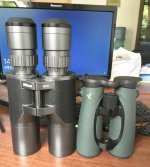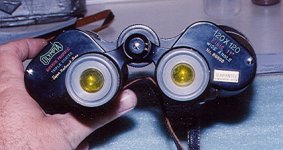Hola, WJC:
There would seem to be remarkably little interest in instruments similar to the one you posted here; my guess is that Birdforum folks - though maybe unschooled in the intricacies of such things as Seidel aberrations - are still much more likely to be amongst those who know that targets are best identified and enjoyed with a wide-field binocular by being placed in the center of the field, than those who would rush out and buy 120x120s with an 11 degree field of view.
I - as many others here have done, I'm sure - have had the dubious pleasure of having dealt with the general public in the past, but find it far more enjoyable to express myself here as I might amongst those who share the enjoyment of birds and binoculars. At the same time, one may certainly appreciate that an individual whose optical world-view was warped, I mean shaped, by decades of explaining the ins and outs of things optical to the "inexperienced and gullible" might find it hard to alter the habit of a lifetime. But whatever may be the case, I applaud your unstinting efforts to protect the untutored masses from the twin evils of marketing and hype, and wish you all success in preaching the gospel of holy collimation across the internet. :cat:
Regards,
P.
Que pasa, Patudo:
— There would seem to be remarkably little interest in instruments similar to the one you posted here;
I am aware most of the members of BirdForum are a cut above. But I can’t focus my thoughts exclusively on optically endowed people. I am aware there are those here who are academically MILES ahead of me: David, Henry, Ed, others. Heck, sometimes I will even pay attention to what ... Gijs has to say. 8-PThat doesn’t mean the lowly practitioner has no place in the puzzle. Even a broken clock is accurate twice a day.
The “similar” instrument you speak of was ONLY AN EXAMPLE. I realize most people are using roof prism binos today. I also know that snake oil selling techniques still abound. BF members are by and large above the problem. But the problem is still out there. And as long as people see distortion and call it field curvature, see a collimation error and say their binocular won’t FOCUS, use depth of field in the vein of PERCEIVED 3-D imaging, or believe the light grasp of their bino is equal to the surface area of BOTH objectives, it will remain so. Some people find it far easier to pontificate on unscientific opinions than spend a little time researching the facts. In so doing, the honest truth-seeker can get easily sucked into a non-productive rabbit hole.
I teeter on the fence of knowing whether you understand my thinking or not. Either way, it doesn’t matter. What people think of Bill the old optician is of no importance. What they might learn through his many ramblings is very important, at least to those who give more than lip service to wanting realistic answers to their sincere questions.
With “... in preaching the gospel of holy collimation across the internet,” I get the impression you think I’m a one-note singer. Actually, when it comes to binoculars, I know ... TWO NOTES.
People expend 10s of thousands of words a year talking about things that annoy them: small fields of view, inadequate eye relief, grazing glare, “squared” exit pupil, curvature of field, excess lateral color, and MANY other things. The fact is that all their words are not going to change one of these problems one iota! The problem can only be solved through the transfer of some of those little colorful pieces of paper found in the wallet.
COLLIMATION IS THE ONLY ANOMALY THAT CAN BE ADDRESSED BY THE INDIVIDUAL. Thus, I am of the opinion that the observer SHOULD be willing to learn the scientific method for solving that problem. Is that so wrong of me? The Internet has many sites portraying the solution to the problem. However, as of this date NOT ONE IS ACCURATE. YEP, YOU CAN QUOTE ME ON THAT. They all deal with conditional alignment, and nothing more. If the error is minor and the observer’s spatial accommodation great, that might be all that is required ... if the bino is to be used by one observer or others with the same IPD. HOWEVER, IT IS NOT COLLIMATION!
But do those passing off this bad information know that by following those instruction alignment could be made worse or that the instrument COULD be damaged? “WHAT ... DID I DO THAT?”— Steve Urkel.
Yes, Patudo, I beat the drum as loud as I can. I have to just to make even a DENT in the foolish, untutored bull that is awash on the Internet. If you think my feelings are too close to the surface, you’re not alone ... I DO TOO! But after four decades for monograms, articles, lectures, and books my nerves are a little raw. I WANT to help those who want to be helped. But in order to do so, I find I must scale the never-ending wall of misinformation, some of which is innocently put forth, while others offer it as if they have just devised a sure-fire 10-minute brain surgery technique.
I keep seeing how “easy” it is from people who are absolutely CLUELESS on the subject.
Is it easy? For someone who KNOWS what he’s doing ... yes, it is!!!
For all others, no it isn’t. Understanding the procedure for performing 3-axis binocular collimation would take a whole page to page and a half and 6-7 minutes to read and think about. But with so many members of bino forums caring as much for opinions as facts, I have a hard row to hoe. Please don’t think the worst of me for trying to help my neighbor. The guys at the Center for Optical Sciences and SPIE think my opinion might just a touch better than the one that now graces the Internet. :cat:
Cheers,
Bill








